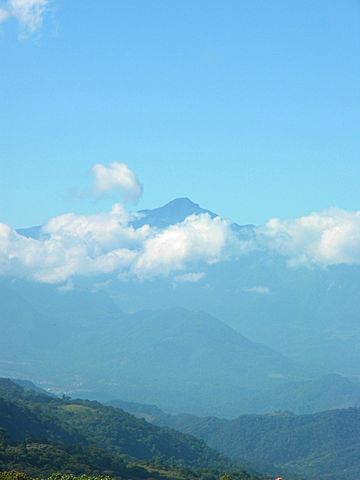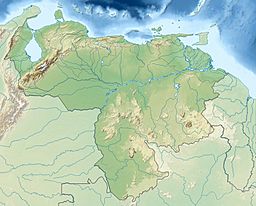Tamá Massif facts for kids
Quick facts for kids Tamá Massif |
|
|---|---|

El Tamá viewed from San Cristóbal, Táchira
|
|
| Highest point | |
| Elevation | 3,613 m (11,854 ft) |
| Naming | |
| Native name | Error {{native name}}: an IETF language tag as parameter {{{1}}} is required (help) |
| Geography | |
| Parent range | Cordillera Oriental (Colombia) |
The Tamá Massif (also called Macizo del Tamá in Spanish) is a group of mountains. It sits right on the border between Colombia and Venezuela. You can find it south of Lake Maracaibo. This mountain area has different types of forests. At lower elevations, there are evergreen rainforests and cloud forests. Higher up, you'll find unique areas called páramos, which are like high, wet grasslands.
Contents
Where is the Tamá Massif?
The Tamá Massif is an extension of the Eastern Mountain Range of the Colombian Andes. It is separated from the Cordillera de Mérida in the Venezuelan Andes by a low area. This area is called the Táchira depression. More than 50 million years ago, this depression was a narrow sea channel. It connected Lake Maracaibo with the Orinoco River basin.
The mountains here range in height from about 320 meters (1,050 feet) to 3,329 meters (10,922 feet). The average temperature in the area is around 25 degrees Celsius (77 degrees Fahrenheit). It also gets a lot of rain, about 2,300 millimeters (90 inches) each year.
To protect this special place, two national parks were created. The Tamá National Natural Park is in Colombia. The El Tamá National Park is in Venezuela. Together, these two parks form a large protected area. It covers about 1,390 square kilometers (537 square miles).
Mountains and Rivers of Tamá
The Tamá Massif is made up of many folded mountain ranges. This means the land is very steep and rugged. Some of the highest points include the El Tamá páramos, which are about 3,320 meters (10,892 feet) high. There is also Cerro El Cobre at 3,613 meters (11,854 feet) and Cerro Judío at 3,372 meters (11,063 feet).
The rocks in these mountains are mostly limestone or sandstone. These types of rocks are common in the Guiana Shield region. Inside the Tamá National Natural Park, there is an amazing waterfall. It is about 820 meters (2,690 feet) high, making it one of the tallest in the world.
The high páramos are the source of many rivers. These include the Carapo, Chiquito, Quinimarí, Quite, and Sarare rivers. These rivers either flow into the Orinoco basin or into Lake Maracaibo. The Táchira River also flows into Lake Maracaibo. It forms part of the border between Colombia and Venezuela.
Wildlife and Plants of Tamá
The Tamá Massif has four main types of natural environments. These are tropical rainforest, sub-Andean forest, Andean forest, and páramo. The forests are part of the Venezuelan Andes montane forests ecoregion. This region also covers the main Venezuelan Andean mountains.
Forests and Plants
Between 800 and 1,800 meters (2,600 and 5,900 feet) high, the forests are very thick. They are evergreen rainforests with tall trees. There are also many smaller plants growing underneath the trees. You can find many epiphytes here, which are plants that grow on other plants. One colorful plant found in these forests is Lagenanthus princeps.
In the higher páramo areas, the plants are different. You can find species from groups like Jamesonia, Oreobulus, Gentiana, and Vaccinium. These plants are adapted to the cool, wet conditions of the high mountains.
Animals of Tamá
The Tamá Massif is home to many interesting animals. Some of the mammals include the spectacled bear (Tremarctos ornatus), which is the only bear native to South America. You might also see tapirs, lowland pacas (Cuniculus paca), anteaters, and ocelots (Leopardus pardalis).
Two special animals found here are the wood sprite gracile opossum (Gracilinanus dryas) and Luis Manuel's tailless bat (Anoura luismanueli). These animals live in both the Andean Mountains and the Tamá Massif.
The area is also important for birds. Some rare birds found only in this region include the Táchira antpitta (Grallaria chthonia), hooded antpitta (Grallaricula cucullata), and Venezuelan wood quail (Odontophorus columbianus).
Two types of frogs are also unique to the Páramo de Tamá. These are the Tamá harlequin frog and Helena's marsupial frog. They are found nowhere else in the world.
See also
 In Spanish: Macizo de Tamá para niños
In Spanish: Macizo de Tamá para niños


